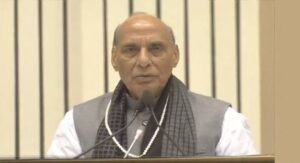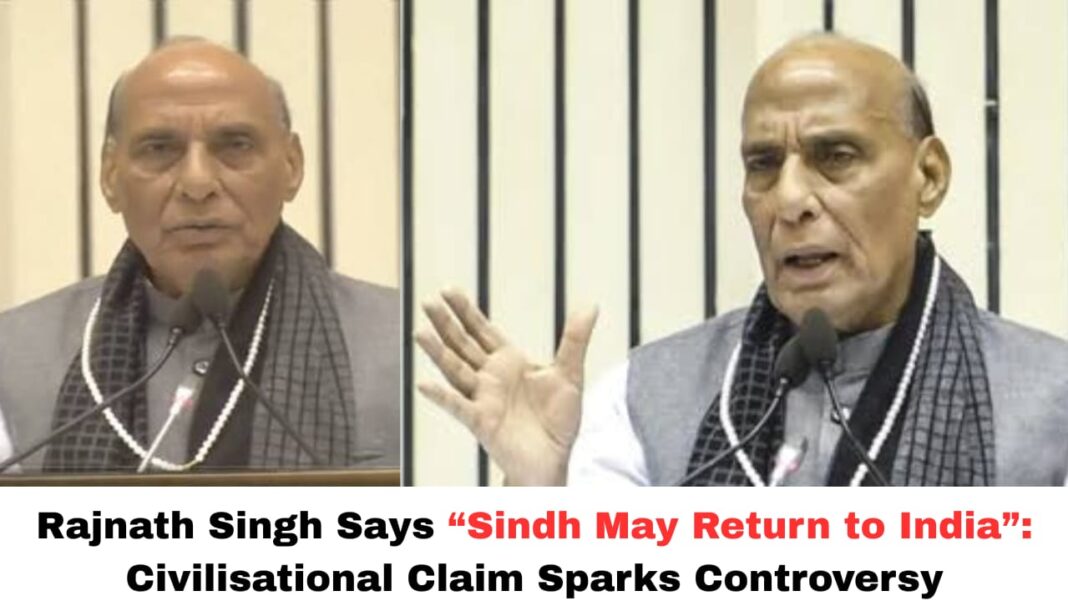Digital News Guru New Delhi Desk:
Rajnath Singh on Sindh
In a provocative speech delivered at a Sindhi community gathering in New Delhi, India’s Defence Minister Rajnath Singh stirred fresh controversy by suggesting that Sindh, the Pakistani province along the Indus River, could “return to India” in the future — asserting that “borders can change.” His remarks, framed in cultural and civilisational terms, have triggered a strong diplomatic backlash from Pakistan and reignited debates over nationalism, history, and geopolitical ambition.
The Statement: Civilisational Ties and Changing Boundaries
Speaking at the Sindhi Samaj Sammelan in Delhi, Singh emphasized the deep, enduring connection between Sindh and India. While acknowledging that Sindh is not part of modern-day India, he said that civilisationally, it always will be. “Today, the land of Sindh may not be a part of India,” Singh said, “but civilisationally, Sindh will always be a part of India. And as far as land is concerned, borders can change. Who knows, tomorrow Sindh may return to India again.”

He cited L. K. Advani, the veteran BJP leader, to underline his point, noting that many Sindhi Hindus of Advani’s generation never fully accepted the separation of Sindh in 1947. Singh also evoked the spiritual significance of the Indus River (Sindhu), saying that many Hindus — and even some Muslims in Sindh — have historically regarded its waters as sacred, a sentiment Advani described in his writings.
Singh went further to assert an emotional bond: “Our people of Sindh … will always be our own. No matter where they are, they will always be ours.” He also invoked the Citizenship Amendment Act (CAA) during his remarks, defending it as a measure designed to protect persecuted minorities — including Sindhis — from neighboring countries.
Reading Between the Lines: What Does It Mean Politically?
Rajnath Singh’s remarks are loaded, both emotionally and ideologically. Here are some key takeaways:
- Civilisational Nationalism
Singh is not speaking purely in geopolitical or territorial terms; he is leaning on civilisational identity. By invoking figures like Advani and traditions tied to the Indus, he frames Sindh not just as a lost piece of land, but as an integral part of a broader cultural-political identity. This resonates strongly among the Sindhi diaspora in India — many of whom trace their roots to Sindh but left in the aftermath of Partition. - Symbolic Overreach vs. Realpolitik
Whether this is a practical territorial ambition or more symbolic posturing is an open question. On the face of it, there is no announced Indian government policy or plan to reincorporate Sindh by force or diplomacy. Rather, the rhetoric may be aimed at evoking emotional support, strengthening nationalist narratives, and reminding the public of a civilisational past. That said, such language is risky — it can easily be interpreted as aggressive expansionism, especially by neighbors.
- Domestic Political Utility
For the BJP and its political base, this statement could serve multiple internal purposes: reaffirming Hindu-majority cultural links to pre-Partition lands, energising the Sindhi community in India, and reinforcing a nationalist narrative about India’s civilisational heritage. By linking it to the CAA, Singh signals that protecting minority communities (in this case, Sindhi Hindus) remains a core concern of his political worldview. - Geopolitical Risk
The potential downsides are significant. Pakistan’s very sharp response suggests that such statements risk escalating diplomatic tensions. While India has not indicated any concrete steps to alter borders, even symbolic claims can be provocative. In a region already volatile, rhetoric about changing borders can feed into distrust, potentially affecting bilateral ties, trade, and security cooperation.
Historical Resonance
Sindh occupies a deeply symbolic place in the subcontinent’s history. Once part of undivided India, Sindh was home to a thriving Sindhi Hindu population before Partition in 1947. After Partition, many Sindhis migrated to India, and the community carried with it memories of displacement and nostalgia for their ancestral lands.
Beyond the human story, Sindh is also the cradle of the Indus Valley Civilisation, making it significantly important in terms of cultural heritage. By referencing this ancient legacy, Singh ties modern political rhetoric to deep historical roots — a powerful narrative device in Indian political discourse.

Broader Implications
- Regional Diplomacy: Singh’s remarks could complicate India-Pakistan diplomacy. In a bilateral relationship already weighed down by Kashmir and cross-border terrorism, such civilisational claims risk being interpreted as subtle irredentism.
- Domestic Narrative: This play strengthens the ideological strands within India that emphasize civilisational unity over geopolitical boundaries. It may feed into election-time narratives, particularly among communities that feel a cultural continuity with regions lost during Partition.
- International Law and Norms: From a legal perspective, borders are sacrosanct in modern international relations. While Singh’s statement is more symbolic than declarative policy, repeated rhetoric of this kind could undermine norms around sovereignty and non-interference.
Conclusion
Rajnath Singh’s declaration that “Sindh may return to India” is less about immediate territorial ambition and more about civilisational identity, emotional resonance, and political messaging. By invoking historical figures like Advani, the spiritual significance of the Indus, and the pain of Partition, Singh taps into a powerful narrative that transcends geography.
You May Also Read: Andhra Doctor Dies by Suicide After US J-1 Visa Denial








